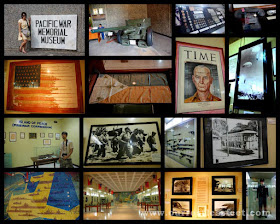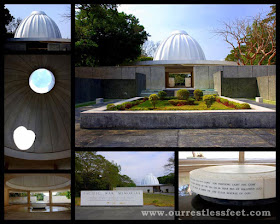
WHERE: Higantes Group of Islands/ Islas de Gigantes, Carles, Northern Iloilo
DATE OF TRAVEL: October 15-16, 2011
WHY YOU SHOULD GO:
1. This group of islands is one of Iloilo's hidden gems. Its far location (northeastern tip of Iloilo) makes it a less commercialized destination even to many Ilonggos themselves.
2. If you're looking for raw beaches, the beaches here will definitely satisfy you.
3. The boat ride going to the islands is a treat itself. On our way there, we saw lots of flying fish, flocks of shorebirds and a seasnake going up for some air!
FEES: P2,500/ boat (Island Hopping, about 4-5 islands), P200/ head/ night at Gigantes Hideaway Inn
NOTE: There are no stores in most of the islands so it's best to bring food and drinks with you on the boat. It's also advisable to leave for the islands early in the morning, which means it's better to stay in the town of Estancia or Carles the night before to avoid late departure from the port.
DESCRIPTION: Higantes Group of Islands or Islas de Gigantes is a group of at least 10 islands and numerous caves at the northeastern tip of Iloilo province. Technically part of Carles town, it may also be accessed via the town of Estancia. Its name supposedly came from a belief that long ago, the islands were inhabited by 'giants' or 'big people'. In Filipino and in Spanish, big people are called 'higantes'. Mostly composed of raw, white sand beaches, it also boats of a natural lagoon with limestone rock formations similar to those in Palawan. Here are the islands of Higantes we explored:

BALBAGON ISLAND - A long stretch of white sand with a small community living at the back. If you're looking for a beach where you can just relax and read a book, this is the one for you. It's also the nearest island from the port of Carles town.

GAKET-GAKET ISLAND - A sandbar with two coconut trees and small huts for fishermen who are out at sea. Because of its ideal location, fishermen stop here every so often before continuing their journey or going home.

TANGKE SALTWATER LAGOON - The only saltwater lagoon in this group of islands, this is Isla de Gigantes' star attraction. Here, you will find yourself in the middle of a saltwater lagoon that is surrounded by limestone rock formations. Its blue-green and shallow water (during low tide) are reasons enough for one to take a dip, sit down and look up to appreciate nature's beauty and listen to the numerous bird calls. This breathtaking lagoon is supposedly where the old Filipino film "Pinakamagandang Hayop sa Lupa" was shot.

CABUGAO GAMAY ISLAND - Composed of "two" beaches and beautiful rock formations, this is our favorite beach among all. Its inviting waters is perfect for swimming, while you can choose your sunbathing spot on its spacious soft sands. Do not miss climbing the rock formations for a great view of the beaches and the vast ocean.

ANTONIA ISLAND - A small island composed of beautiful rock formations, white sands, coconut trees, azure waters and a family of dogs ready to welcome you anytime.

BANTIGUE SANDBAR - The most beautiful sandbar in this group of islands, Bantigue Island is supposedly best visited at sunset. We didn't get to go at that time but was still amazed at the sand's snakelike formation.

SICOGON ISLAND - Sicogon Island, as others describe it, was THE Boracay of the 1990's with its white sands and highly developed establishment. It used to be a luxury resort which flew in foreigners from different parts of the world. Today, the resort is no longer existing and communities have already settled in the island, but its beauty still remains. With a close canopy forest which is home to about 97 kinds of trees, their mountain is absolutely worth exploring. In our opinion, we don't see it as a "thing of the past", but an island with so much potential. Too bad we weren't able to bird in the area, but the site looks promising.

ASLUMAN ISLAND, HIGANTES NORTE - While this island doesn't have a beach for swimming, it boasts of numerous caves worth exploring. Too bad it rained a couple of days before we arrived, which made the trails very muddy and hardly accessible. This is where you will spend the night if you choose to do the Island Hopping Overnight Package with Tourism Officer Joel Decano, and you will be staying at Gigantes Hideaway Inn, a small homestay-like place with really cute native designs. We spent the afternoon and morning exploring the island - from watching the sunset and birdwatching at the mangrove area in front of the inn to walking at the foot of the hill in search of birds to watching the people as they gather shells and take out the scallops which they will sell at the public markets. At least one member of each family in the community is involved in the business of scallops and shells - whether it be gathering shells or taking out the scallops or collecting the colored shells which they sell to exporters and shellcraft makers. Such is the business of shells in the island that even their sands have turned into shells! Only two things concern us here: 1) Since they claim that they do not farm the scallops, what happens when they don't reproduce enough anymore, or don't reproduce at all? and 2) We think the mountains of shells that are just scattered all over the island can be put to better use (maybe crafts?). Nevertheless, Asluman Island is an interesting place to see. If you're feeling lazy, you can just hang out in Gigantes Hideaway Inn's huts and/or native beds.
Some places we didn't get to visit: Lighthouse (Parola); Caves (Pawikan, Langub, etc), Uaydajon Island, Puting Baybay (Lumpatan Rock), Pulupandan Island
HOW TO GET THERE: From Manila, you can fly to either Iloilo City, Iloilo or Roxas City, Capiz.
Once you land in Iloilo City, you can take a cab from the airport to Tagbak Terminal then take a CERES bus bound for Carles. Contact Tourism Officer Joel Decano (contact number below) once you're in Carles. You can also take a shuttle from the airport to Jaro (P50.00). From there, walk going to the plaza and ask around where the jeepneys headed to Tagbak Terminal pass. Jeepney costs less than P10.00.
You can also take an Estancia bound bus from Tagbak Terminal. One passenger ferry leaves from Estancia Fishing Port to Isla de Gigantes Sur daily at around 2:00 pm and leaves the next day at around 7:00 am. You can hire fishermen to take you around for some island hopping for about P2,000.
If you choose to fly to Roxas, Capiz, you can take Estancia or Carles bound buses.
Travel time to Carles/ Estancia from Iloilo City is about 4 hours, and 2 hours from Roxas City.
CONTACTS: Joel Decano, Tourism Officer of Carles, Iloilo - +63918 4685006. You can also add ISLA GIGANTES as a friend on Facebook.
SPECIAL THANK YOU: To Sir Joel Decano, for accompanying us and arranging out stay. We would also like to thank Mayor Arnold Betita (Mayor of Carles town) for making us stay in his home for one night and for covering our island hopping expense upon learning that we have a blog and that we frequently travel around the country. Thank you both for your hospitality. We truly enjoyed our stay. :)
-2.jpg)





















